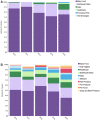Bioactives in bovine milk: chemistry, technology, and applications
- PMID: 34879147
- PMCID: PMC8653947
- DOI: 10.1093/nutrit/nuab099
Bioactives in bovine milk: chemistry, technology, and applications
Abstract
The significance of dairy in human health and nutrition is gaining significant momentum as consumers continue to desire wholesome, nutritious foods to fulfill their health and wellness needs. Bovine milk not only consists of all the essential nutrients required for growth and development, it also provides a broad range of bioactive components that play an important role in managing human homeostasis and immune function. In recent years, milk bioactives, including α-lactalbumin, lactoferrin, glycomacropeptide, milk fat globule membrane, and milk oligosaccharides, have been intensively studied because of their unique bioactivity and functionality. Challenges for the application of these bioactive components in food and pharmaceutical formulations are associated with their isolation and purification on an industrial scale and also with their physical and chemical instability during processing, storage, and digestion. These challenges can be overcome by advanced separation techniques and sophisticated nano- or micro-encapsulation technologies. Current knowledge about the chemistry, separation, and encapsulation technology of major bioactives derived from bovine milk and their application in the food industry is reviewed here.
Keywords: bioactive components; bovine milk; encapsulation; glycomacropeptide; lactoferrin; milk fat globule membrane; milk oligosaccharides; separation; α-lactalbumin.
© The Author(s) 2021. Published by Oxford University Press on behalf of the International Life Sciences Institute.
Figures





References
-
- Centers for Disease Control and Prevention. Risk for COVID-19 infection, hospitalization, and death by age group. 2020. https://www.cdc.gov/coronavirus/2019-ncov/covid-data/investigations-disc.... Accessed May 6, 2021.
-
- Santos DI, Saraiva JMA, Vicente AA, et al. Methods for determining bioavailability and bioaccessibility of bioactive compounds and nutrients. In: Innovative Thermal and Non-Thermal Processing, Bioaccessibility and Bioavailability of Nutrients and Bioactive Compounds. Sawston, Cambridge: Woodhead Publishing: Woodhead Publishing Series in Food Science, Technology and Nutrition; 2019:23–54. doi:10.1016/B978-0-12-814174-8.00002-0
-
- Korhonen HJ. Bioactive milk proteins, peptides and lipids and other functional components derived from milk and bovine colostrum. In: Saarela M, ed. Functional Foods. 2nd ed. Sawston, Cambridge: Woodhead Publishing: Woodhead Publishing Series in Food Science, Technology and Nutrition; 2011:471–511. doi:10.1533/9780857092557.3.471
Publication types
MeSH terms
Substances
LinkOut - more resources
Full Text Sources
Other Literature Sources

